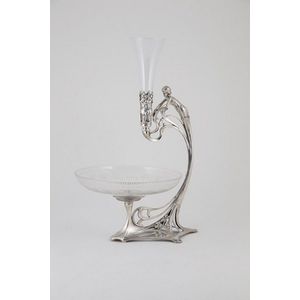Art Deco Diamond Lozenge Ring
You must be a subscriber, and be logged in to view price and dealer details.
Subscribe Now to view actual auction price for this item
When you subscribe, you have the option of setting the currency in which to display prices to $Au, $US, $NZ or Stg.
- Art Deco Period - The Art Deco period was a cultural movement that emerged in the 1920s and 1930s, and was characterized by its emphasis on modernism, luxury, and elegance. The name "Art Deco" comes from the Exposition Internationale des Arts Décoratifs et Industriels Modernes, a large exhibition held in Paris in 1925 that showcased the latest trends in decorative arts.
Art Deco was a reaction against the ornate and elaborate styles of the previous era, and reflected a new modern sensibility. It was characterized by streamlined, geometric shapes, bright colours, and the use of new materials such as chrome, glass, and Bakelite. Art Deco designers sought to create a sense of luxury and sophistication, often incorporating expensive materials such as ivory, marble, and rare woods.
Art Deco had a significant impact on a wide range of artistic fields, including architecture, fashion, graphic design, and interior design. Some of the most iconic examples of Art Deco architecture include the Empire State Building in New York City, the Hoover Building in London, and the Palais de Chaillot in Paris.
The Art Deco period came to an end in the 1940s, as World War II and changing cultural trends led to a shift in artistic styles. However, Art Deco remains an important influence on design and art, and continues to be celebrated for its modernist sensibility and glamorous aesthetic. - Brilliant Cut - In their naturally occuring state diamonds have little life or sparkle and for many centuries were simply cut in half and worn in amulets. Invented at the end of the 17th century by a Venetian diamond cutter, a "brilliant cut" diamond has 58 facets arranged in a regular geometric relationship, with 33 above the crown and 25 below on the pavilion.
The introduction of the brilliant cut increased the popularity of diamonds in jewellery as it was the first cut to reveal the fire of the diamond, with the light being internally reflected from one facet to another, and was superior to the previously used table cut and rose cut.Variants to the brilliant cut have emerged since the end of the 17th century, but the popularity of the original brilliant cut has continued to the present time, where it is still the most commonly found cut.
.
This item has been included into following indexes:
- rings, diamond
- rings, diamond solitaire - diamond solitaire / claw set brilliant cut 6,818
Visually similar items

9ct yellow gold fancy link fob chain with t-bar, weight: 34.4 grams, size: 49 cm length

A Cantonese folding fan, Qing dynasty, 19th century, with a group of figures in a pavilion, polychrome with ivory heads, and the sixteen black lacquer sticks with gilt decoration, in original box, the fan 28 cm, together with a second painted lacquer box,

William F c1905 silverplated epergne in the high Art Nouveau style, the elongated stand cast with a female figure with clear glass trumpet, with pierced floral decorated lozenge shaped base holding an etched glass bowl

A set of six Lalique 'Champigny' glass plates, circa 1933, year of issue, model 10-3012, salad or entree plates of plain design with a chevron border to the foot rim, engraved mark of Lalique France to base. Diameter 21 cm
